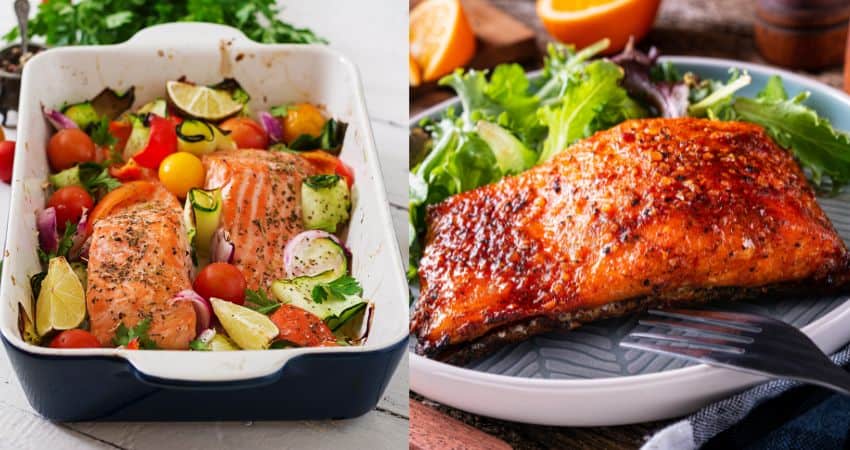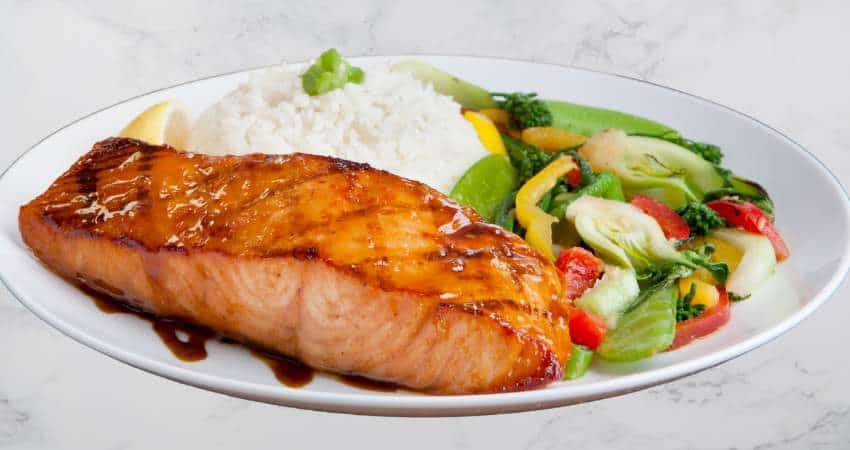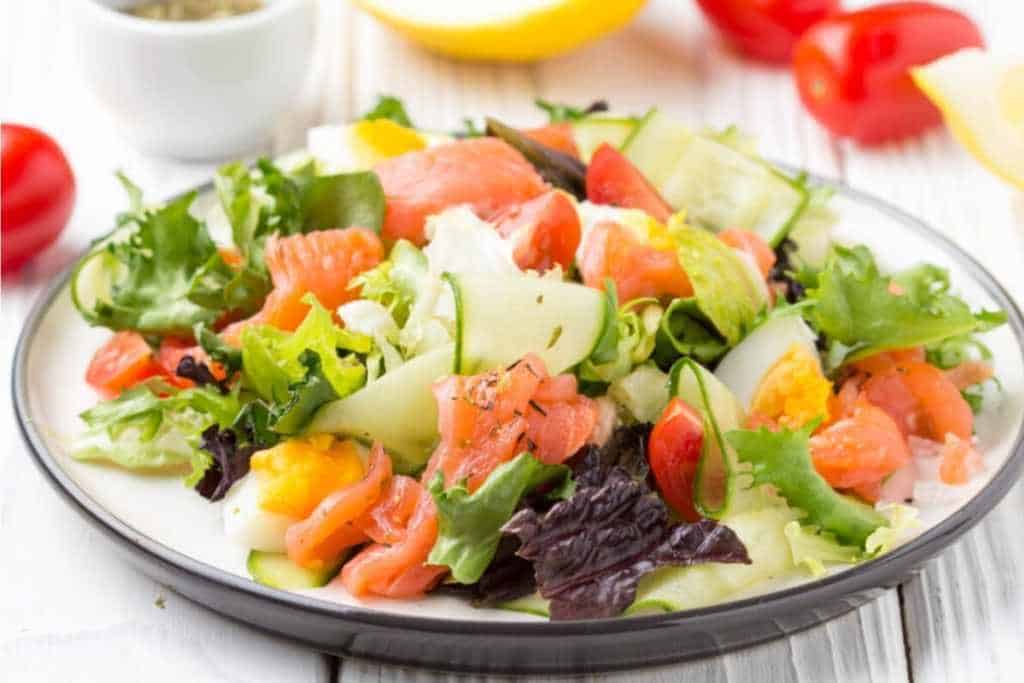Atlantic vs Wild Salmon: Which Is Better?
There are different kinds of salmon you can buy for any dish. Two of these options are Atlantic (generally farm-raised) and wild salmon, which is better?
Wild salmon are better nutritionally and for cooking than Atlantic salmon. Wild salmon has a lower fat content and higher protein content than Atlantic salmon, it cooks at a lower temperature, and it does not have the same chemical or pollution risks that Atlantic salmon do.
While wild salmon is better in many areas, that doesn’t mean you should discount the benefits of purchasing and cooking Atlantic salmon. They both have their pros and cons in many different areas. Therefore, keep reading to determine which kind of salmon works best for you.
Atlantic and Wild Salmon: the Difference

As a Certified Health Coach many clients ask me about food comparisons including salmon. I purchase and consume salmon every week. Therefore, I have researched this topic in the past and present. Let’s examine them closely.
It is important to understand the main differences between these two fish. The biggest difference to understand is where both kinds of salmon come from because it has a huge effect on the meat people consume.
Atlantic and wild salmon come from two very different places which end up having a huge effect on the meat and nutritional value of each fish1.
Atlantic salmon are pretty much all farmed fish these days2. There are few wild Atlantic salmon left, as they are endangered and the rivers they swim up to breed are often closed off by dams.
To preserve the population, they are usually bred and farmed in fish pens or cages. Salmon from fish farms don’t get to swim long distances, they are fed artificial food, given antibiotics and are close to much pollution3.
All of these conditions change the texture, nutritional content and risks of the salmon we cook and eat. If you find wild caught Atlantic Salmon, it is similar to wild caught salmon in nutrients, benefits, costs, substitutions, taste and texture.
Wild salmon are quite different than Atlantic salmon. There are plenty of places where people can fish for wild salmon as they are not endangered and their habitats are preserved.
Wild salmon, as their name suggests, are caught straight from their wild habitats of rivers and oceans, with no farming involved. Because these salmon are able to live in the wild, they get to swim long distances when migrating.
They eat other animals with no artificial ingredients and are generally not directly exposed to antibiotics or pollution.
Atlantic vs Wild Salmon: Nutrition
The first important part of these two salmon to understand is their differences in nutritional value. Knowing how Atlantic and wild salmon differ nutritionally may be the factor prompting you to buy one kind over the other at the store.
Typically, wild salmon are much more nutritionally dense than Atlantic salmon and pose fewer health risks to the consumer ((Nutrition Value: Fish, raw, wild, Atlantic, salmon)).
Fat Content, Calories, and Protein
The biggest nutritional difference between these two fish is their fat content4. Wild salmon have much lower fat levels than Atlantic salmon do. This is because wild salmon swim long distances and constantly work the muscles in their bodies which lowers the fat content.
Atlantic salmon, on the other hand, have an excessive amount of fat for a salmon. Some have as much as four times the fat as a healthy wild salmon. This is because they are kept in relatively small cages and do not work their muscles frequently.
The food Atlantic salmon are fed contains grains meant to make them larger and have more fat. This form of feeding helps each fish produce more meat, which makes more money.
Omega-3s
One of the biggest reasons people eat salmon and other seafood is because of the Omega-3s they provide. It is recommended a healthy adult gets 250-500 milligrams of Omega-3s per day.
This substance is important for heart health, brain function, eyesight and energy production ((National Center for Biotechnology Information: Benefits of salmon eating on traditional and novel vascular risk factors in young, non-obese healthy subjects)).
While fatty fish are not the only food giving you these nutrients, salmon does provide the necessary Omega-3s.
Chemicals, Antibiotics, and Pollution
The final big, nutritional difference between these two kinds of salmon is the risks to your health eating salmon can bring. Wild salmon are much less risky compared to Atlantic salmon. Eating wild salmon is less risky when it comes to health.
Wild salmon, while farther away from pollutants, are still exposed to chemical pollutants. Especially when caught on coasts, the waters wild salmon swim in are, unfortunately, polluted to some degree5.
When salmon eat food that lives in polluted waters, the chemicals transfer over to the meat.
While wild salmon is not completely safe from being polluted, Atlantic salmon is much worse in this area. These fish are farmed in places exposed to a lot of pollution, and they generally are living right next to a polluting factory.
In addition, Atlantic salmon sometimes eat artificial food containing many chemicals you would not want to eat, like arsenic, PCBs and even mercury.
Atlantic salmon are given antibiotics to help prevent diseases from being spread with so many fish close together. These antibiotics are often absorbed into the flesh which is then consumed by people.
Atlantic and Wild Salmon Tastes

The nutritional value and dangers of both kinds of salmon are incredibly important to consider when choosing which kind to buy. In addition to nutrition, the taste of wild and Atlantic salmon differ6.
Whether you prefer one over the other can change which kind you purchase. As a general rule, wild salmon tastes more full and powerful compared to Atlantic salmon.
Wild salmon does have a more full taste than Atlantic salmon. What’s meant by “full” is wild salmon has a stronger flavor in each bite for a few different reasons.
The fat stripes in wild salmon are thinner than in Atlantic salmon. This leaves more room for the flavor of the actual meat. Wild salmon consume a richer diet because it is not artificial and they are generally healthier.
A healthy fish provides more flavor and wild salmon are healthier during their lifetime.
Atlantic salmon have a more muted flavor than wild salmon. There are thicker stripes of fat in the meat which take away much of the room for flavor. Atlantic salmon are raised in unhealthy environments where they have to fight for food and space.
The food they eat is artificial and provides them with fewer nutrients which can give the fish better flavor.
My Own Poll and Taste Test at Home
I wanted to get the opinion of real people like you and me. Therefore, I wanted to conduct my own research and contacted my clients, readers and members of food groups I belong to. I asked them which salmon they preferred.
- 52% said they preferred the taste of wild salmon.
- 39% said they preferred the taste of Atlantic.
- 9% said they had no preference, or it depended on their mood.
I then set up a blind test taste at my home. We prepared both salmons the same way using the same seasonings. Four out of five people, 75% chose the wild salmon. They said the flavor was better.
Atlantic and Wild Salmon Textures
While wild salmon come out on top in the flavor department, Atlantic salmon are actually considered to have a better texture to them. During their lifetime, Atlantic salmon do not get as much exercise as wild salmon, which makes them fatter.
This is where the extra fat in Atlantic salmon comes in handy. When cooked, Atlantic salmon are easier to keep juicy because of the extra fat throughout. This gives the meat a softer, more tender texture than wild salmon. This quality is preferable to many people.
Check out the video towards the end of this article explaining the cooking differences between Atlantic and wild caught salmon.
The texture of wild salmon is not preferred by as many people. It is easier to overcook wild salmon, and many people do so because there is less fat to keep it moist and tender. Instead, wild salmon usually ends up being tougher and drier.
Wild salmon has more dense meat because they spend much time swimming upstream and gaining muscle instead of fat. However, if cooked correctly, wild salmon can come out with a very pleasant texture.
Combined with the exceptional flavor, wild salmon can blow anyone away. But how about Char vs Salmon? Check out my article comparing everything between the two, Char vs. Salmon – A Complete Comparison.
Uses for Atlantic and Wild Salmon
No matter which kind of salmon you end up purchasing, there are a ton of different uses for them. There are endless specific recipes you can use salmon for. Both kinds of salmon, wild and Atlantic, apply to these recipes.
Large Pieces
One way to prepare salmon is in large pieces. This can be as one whole piece, or as a bunch of smaller fillets. If you have many people to feed, you can try cooking an entire side of salmon.
The best way to do this is by putting it in an oven or on a large grill to smoke or grill. Another way of using large pieces is by cooking the salmon in medium-sized fillets. You can do this by baking or grilling the pieces.
You also have the option of cooking salmon fillets in a pan on the stove. This allows you to have more control over the internal temperature of each fillet.
Small Pieces
Another great way to prepare salmon is by using small, bite-sized pieces in salads, pasta and sushi dishes. Bite-sized pieces of salmon are great for adding to all sorts of dishes. Salads benefit greatly from a more hearty ingredient.
Pasta gains extra depth of flavor when salmon is added, and it is flavorful and tender in sushi. Salmon pieces can be eaten raw in sushi and sometimes salad. These pieces benefit greatly from being cooked beforehand when preparing pasta or other hot dishes.
Blended
There are many uses for salmon that has been blended or pulled apart. You can make traditional salmon cakes or even burgers by blending up salmon and potatoes or salmon and various herbs.
You can make a creamy salmon stew by blending up salmon and any other ingredients. Blended or pulled salmon works great as a slaw that can be put on tacos or rolls.

Atlantic and Wild Salmon Substitutes
If you can’t find one or the other, you may be wondering if you can substitute Atlantic Salmon for wild salmon.
Atlantic salmon and wild salmon can substitute for each other in recipes, although they have slightly different textures and tastes. They both can be cooked using many of the same methods like slow-roasted, poached, fried or baked. Substitute the same weight and type of cut.
All of this talk of salmon flavors and versatility could make anybody want to go out and buy some. However, some people are allergic to seafood, including salmon. In addition, their diet or other health restrictions don’t allow them to eat salmon.
If you are craving salmon but you can’t eat it for any reason, there are great tasting substitutions having a high nutritional value and versatility.
Similar Fish
One thing people look for when they require a salmon substitute is another type of fish. This might be because they need a cheaper option or because they just don’t like salmon. There are options similar in texture to salmon. These are fishes are:
- Halibut
- Pollock
- Hake
- Cod
These fish are similar in texture and can be cooked in pretty much the same way salmon is. Some options less similar in texture but similar in richness are shrimp or mussels. The texture is pretty far away from salmon, but the flavors bring a similar seafood smell and likeness to any dish.
Other Options
If you do not eat any seafood, there are still many substitutions for salmon. Seaweed and tofu are often used to create convincing fried fish fillets. Wrapping the tofu in a strip of nori, before coating in batter and frying replicates a fish texture and flavor pretty well.
Smoked carrot salmon is another pretty popular alternative. It involves marinating long, thin strips of steamed carrot overnight and then serving in a variety of different ways.
Generally, you can use any texture of food to make your fish as long as it is seasoned with flavors like soy sauce or mushrooms.
Atlantic or Wild Salmon: Which One Has More Mercury?
The Food and Drug Administration and the Environmental Protection Agency have issued warnings regarding mercury levels. They also provide recommendations about how often people should consume each fish7.
They established a list of fish that are best choices, good choices and ones to avoid. Therefore does Atlantic salmon or wild salmon have more mercury?
Atlantic salmon and wild salmon have similar levels of mercury. All salmon are listed on the FDA’s best choices of fish to consume regarding their mercury levels. The recommendation is consuming them no more than two to three servings a week.
Research has shown both farmed salmon and wild salmon have low levels of mercury8. Mercury is found in both due to the industrial pollution finding its way into the bodies of water.
Always check with a physician prior to eating new foods or changing your dietary habits.
If you’re interested in finding out how the sockeye salmon compared to coho salmon, check out my article here, Coho Salmon vs Sockeye: What’s The Difference?
Atlantic vs Wild Salmon: Which Costs More?
When you are purchasing any kind of salmon, be sure to check the label to see if the fish is wild caught or farm-raised. This makes a difference with cost as wild is always more expensive. In addition, your area, store and whether the fish is frozen or fresh changes the price.
Therefore, which is more expensive, Atlantic or wild caught salmon?
Wild salmon is more expensive than Atlantic salmon which is farm raised. The average cost for fresh wild salmon is $10.99 per pound while the average cost for fresh farm raised Atlantic salmon is $8.99 per pound.
I checked my local Shoprite supermarket and found the following prices for Atlantic and wild salmon:
- Fresh wild pink fillet
- $10.99 per pound
- Fresh farm Atlantic salmon
- $8.99 per pound.
If you have any questions to ask me about this article don’t hesitate to comment below or email us. You can find an email on our contact page.
Read Next – More Salmon vs Salmon Articles!
Pink Salmon vs Sockeye: The Complete Comparison
Atlantic vs Pacific Salmon: What’s The Difference?
Sardines vs Salmon: A Complete Comparison
Frozen Salmon vs. Canned Salmon: Which Is Healthier?
Pink vs Red Salmon: What’s The Difference?
- Oceana: Atlantic Salmon [↩]
- NOAA Fisheries: Atlantic Salmon (Protected) [↩]
- Cleveland Clinic: Fish Face-off: Wild Salmon vs. Farmed Salmon [↩]
- USDA: Fish, salmon, Atlantic, wild, raw [↩]
- Colorado State University: Wild caught vs. farm raised seafood [↩]
- Oregon State University: Farmed Or Wild? Both Types Of Salmon Taste Good And Are Good For You [↩]
- FDA: Advice about Eating Fish [↩]
- Washington State Department of Health: Farmed Salmon vs. Wild Salmon [↩]
